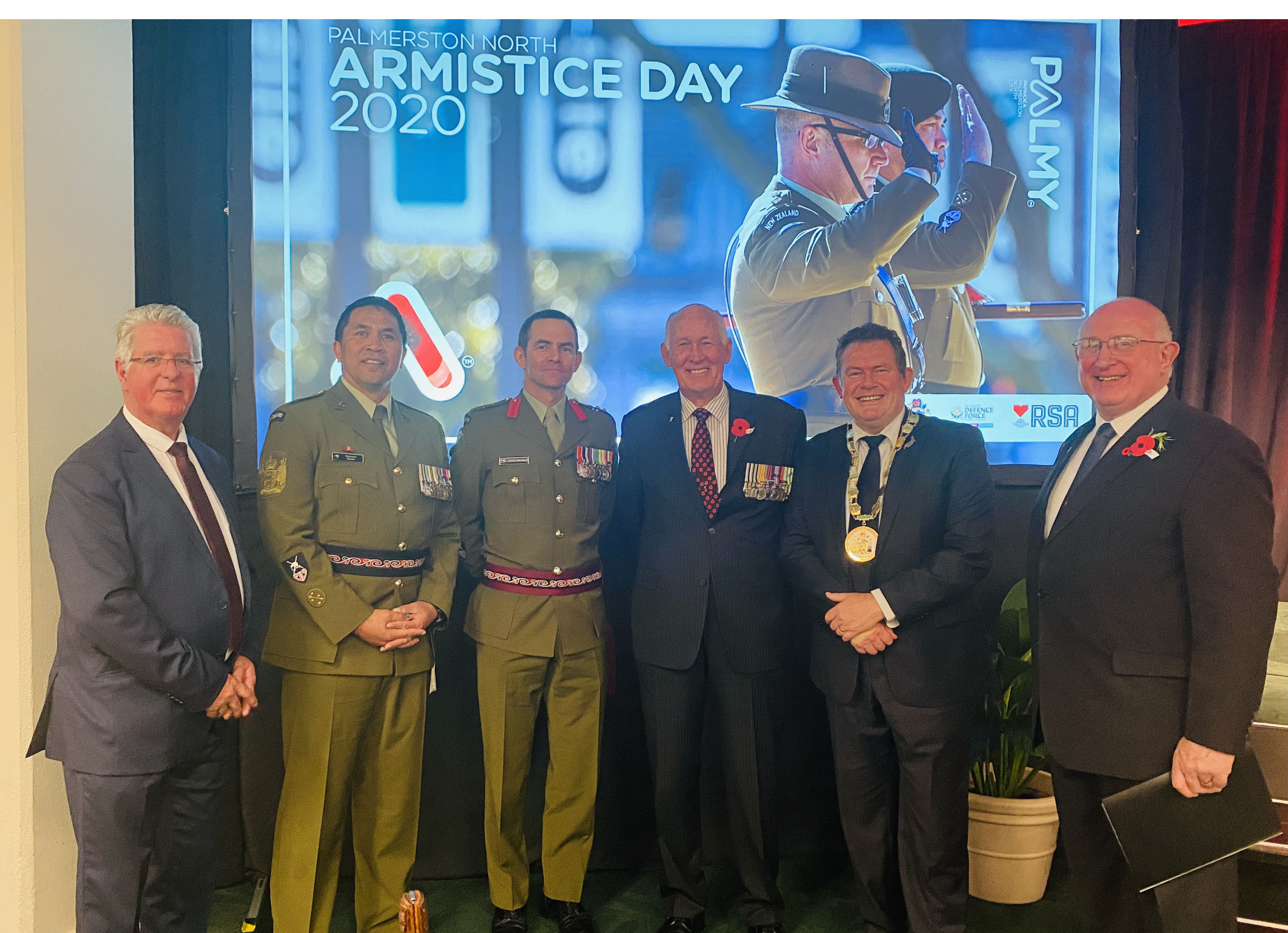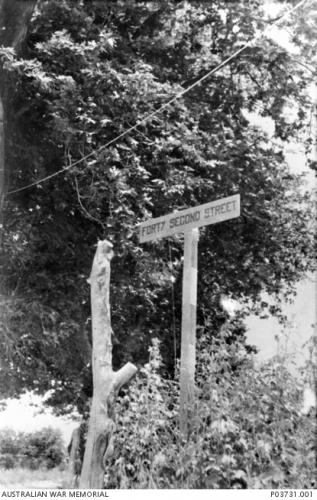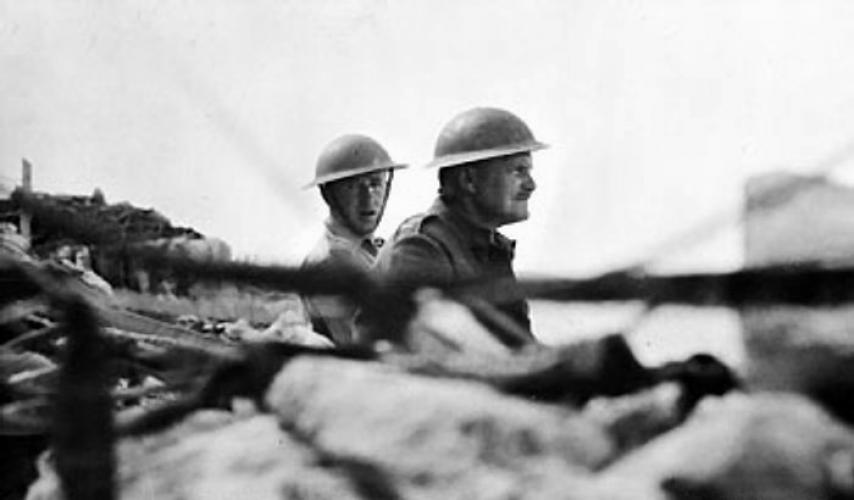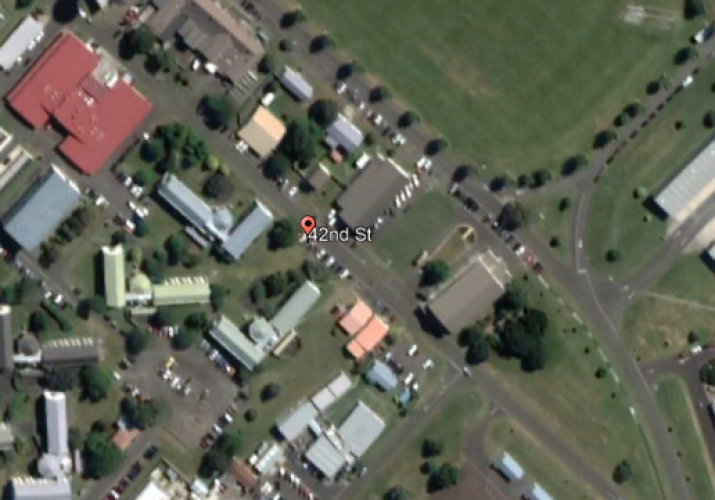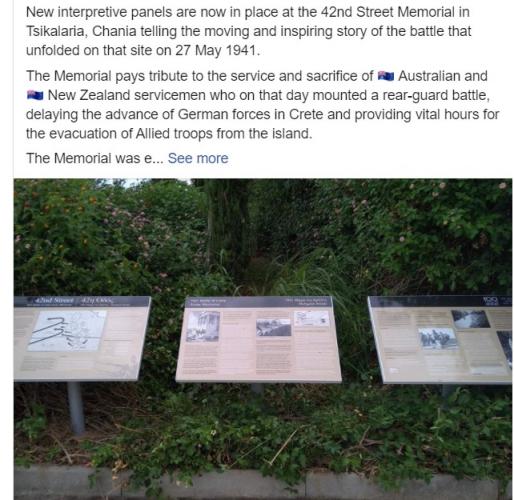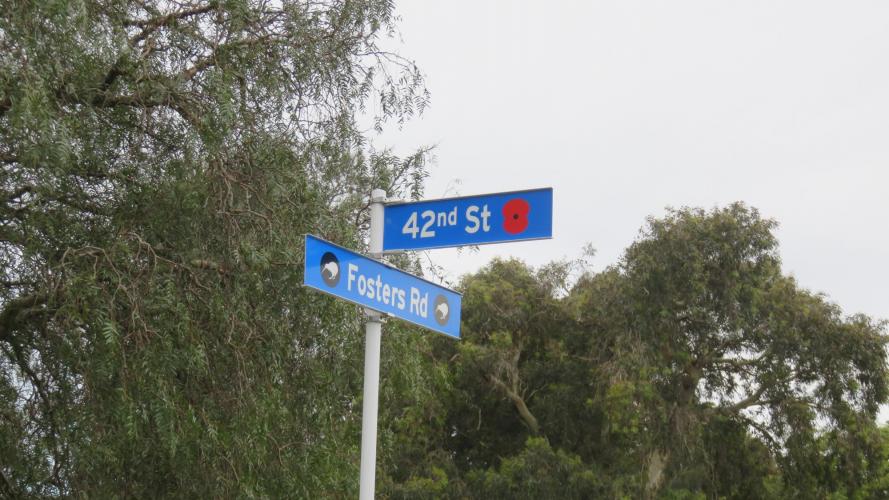An aerial view of 42nd Street, Linton Camp.
Reason for the name
This Linton Camp street is named after a 42nd street in Canea, Crete. It is a tribute to the Anzacs involvement in the battle for Crete during World War 2. Most streets within NZDF Camps and Bases are named in honour of prominent people, battles, campaigns, ships, aircraft and places creating a rich history of our military service.
On 27 May 1941, 42nd Street was the site of a battle between the German 141st Mountain Regiment and two companies of the 2/7 Battalion, joined by New Zealanders of the 28th (Maori) Battalion, stopping the Germans for the rest of the day. The name '42nd Street', a humorous appellation inspired by the musical of the same name, was given by a small group of sappers from the 42nd Field Company, Royal Engineers who had bivouacked beside the dirt lane after being sent to garrison Crete late in 1940. The name was recorded on British maps and passed into common use. With German advances into Crete, allied troops joined together, withdrawing towards Canea and by 27th May occupied a line including 42nd Street, from Suda Bay to the Malaxa escarpment. This was the rear guard of the Commonwealth force retreating southward to Sfakia, site of evacuations.
Author: The Poppy Places Trust
During the initial stages of the fighting on Crete, the Australians defending Heraklion managed to defeat the attack there and blunt the attack at Retimo, holding it for more than a week, however, at Maleme the Germans managed to wrest control of a vital airfield, and as a result began flying in reinforcements of airborne and mountain troops. As the Germans began moving inland to outflank the defenders' positions, the Australian, New Zealand and British forces were forced back towards Chania, which came under heavy air attack by German bombers. By 27 May, the weakened Australian 2/7th and 2/8th Battalions, supported by the New Zealand 21st, 28th, 19th, 22nd and 23rd Battalions, had taken up positions along 42nd Street, south-east of Chania where they formed a rearguard to protect the rest of the Commonwealth forces that were being pushed south. The Anzac units were manned at less than 50 percent of their normal strength, having suffered heavy casualties earlier in the fighting.
The unsealed road ran from Hania to Tsikalaria lined with olive trees running south from the main coastal road from Hania to Souda Bay. The road was lower than the surrounding land and had a raised embankment on its western side that provided cover for defending troops and formed a natural defensive line. The road was nicknamed after the 42nd Field Company of the Royal Engineers, who had previously been camped there; but was known locally as Tsikalarion Road.
The 1st Battalion of the 141st Gebirgsjager Regiment were seen approaching 42nd Street. Advancing along the Souda road, they were estimated by the Australian and New Zealand defenders as numbering about 400 men, and were attempting to raid an abandoned supply depot under the cover of mortar and machine-gun fire. In response, two companies of the Australian 2/7th Battalion – 'C' and 'D' Companies – charged the Germans, on their flank attacking with bayonets and small arms, and heavy close quarters fighting ensued. The New Zealand 28th (Maori) Battalion also joined in the charge, followed by the other battalions, and supported by machine guns of the 2/1st Machine Gun Battalion. The charge resulted in the Germans retreating over 1,500 metres (1,600 yd). Over 280 Germans were killed and three taken prisoner; 10 Australians from the 2/7th were killed and 28 wounded, while the Maori Battalion suffered a further 14 casualties.
Fred Baker, the 28th Maori Battalion's fourth commander wrote from the Middle East on the 24th of June 1941. This extract is taken from his letter where he describes the bayonet charge at 42nd Street.
The next day he decided to switch off other units and have a crack at us. I was one of our forward Coys and he picked on us. He got right up to us and then we caught him from all sides and gave him a hell of a surprise. The ones that got away did not stop till they were at least a quarter of a mile away. His planes came back to us after that of course as well as his mortars and we spent the day dodging. That night we pulled back again as his planes were playing up. He followed up and the next morning early he came right down on us. It was there that we had our greatest bayonet charge - the Bn. had had about four others while up at Maleme Aerodrome and knew what effect they had had. In this one, three other N.Z. Bns. And one Aussie Bn. came in with us and we swept the whole area in front of us for about 1000 yds. The formation was something like this as we went in:
Our Bn. was slightly in front of the others and went straight after him. I am very proud of that show as I lead my whole Coy. (or rather what remained of it) myself, and they lead our Bn. Our Coy was spread out in one single line right across our front and two other Coys followed us, taking up half the front each. Jerry tried to hold us back with everything he had. We had no supporting fire except Bren and Tommy guns fired from the hip as we came. We walked all the way, jumped into his first positions, bayoneted or tommy-gunned them then walked on to his next line. My fellows behaved as if they were on parade and after we got to his second line he started to crack and run. We got to about his fourth line before we met any further opposition. We soon silenced that. By that time all opposition had vanished - the rest of the day he spent in reforming at a safe distance and once again dealing with us from the air. It was during this advance that I got my whang in the right arm - that was during the first 300 yds. I would say. I bled like a stuck pig and as I went on till it petered out I did not feel too hot by the time I got the R.A.P. for attention. Still it was worth it for on our front dead for dead the odds were in our favour by 30 to 1. Then we call him a soldier and we were fighting the famous Jaegar Division at that! Whenever they came near enough we cracked him and as soon as we can keep his aircraft in check he can pack up and go home. They were certainly unnerved on the day I am referring to and their shooting was frightful. I should have been shot to pieces as I was about 10 yds. in front of my crowd and the chap who got me was no more than 20 yds. in front of me. He was behind a tree (this all happened in a big olive grove or groves) and fired two bursts at me with his sub-machine gun and that is all he could do. I know if my life had depended on it I would have done much better, for my boys got him. Strange though it sounds, I was the only casualty in my Coy there, although we stayed in front throughout. I did lose two other men but they had become detached and went in with the Aussies further over. The other losses were in Coys behind us. Jerry won't forget that show in a hurry and for the next five days he handled us very gingerly although his Air Force (like the poor) were always with us.

